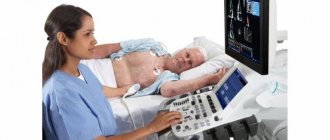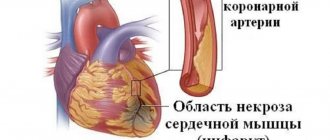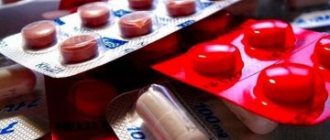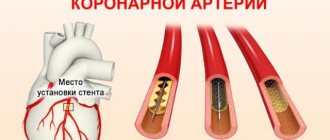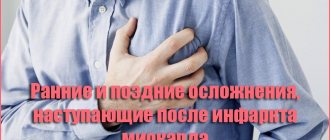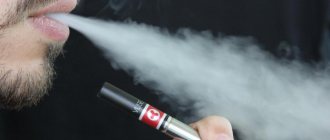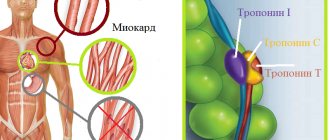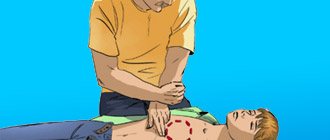The main purpose of a patient with myocardial infarction staying in the intensive care unit is continuous monitoring, stabilization of the condition and, if necessary, resuscitation. Also, in the conditions of this block, preparations for surgery are carried out. The first stage of recovery after surgery also takes place there.
Intensive care departments are equipped with all the necessary equipment, medications and experienced personnel, which allows them to effectively deal with complications and provide emergency care if necessary.
What kind of care is provided to a patient in intensive care?
A patient diagnosed by an ambulance with acute coronary syndrome is immediately taken to the intensive care unit. Often, large cardiology clinics have separate specialized infarction intensive care units.
Resuscitation during a heart attack primarily consists of providing the damaged heart muscle with oxygen, stopping the developed life-threatening arrhythmias, and correcting hemodynamic disorders and thrombus formation.
To do this, the following procedures are used:
- oxygen therapy - the patient is connected to a ventilator to combat hypoxia;
- infusion therapy - indicated to restore normal blood supply to tissues, water and electrolyte balance, and is used to provide parenteral (intravenous) nutrition;
- sedation – during a heart attack it is very important to calm the patient’s nervous system, for which appropriate medications are used;
- pain relief – ischemia of the heart muscle is accompanied by intense pain, which can lead to the development of shock, so it is relieved with the help of narcotic analgesics;
- prevention of thrombus formation or dissolution of a formed thrombus - it is very important to prevent a recurrent attack or to ensure access of oxygen to the ischemic area, for which anticoagulants such as heparin or warfarin are prescribed;
- strict bed rest is necessary to minimize physical activity and restore the body.
While in intensive care, the patient can be treated surgically:
stenting of coronary arteries;- coronary artery bypass grafting;
- laser angioplasty;
- balloon dilatation of coronary vessels.
Patients are in intensive care after a heart attack under constant supervision of medical personnel. They are connected to equipment around the clock, which automatically takes an ECG, monitors blood pressure, respiration, heartbeat and other indicators. If the patient develops clinical death, he is urgently given cardiopulmonary resuscitation, which consists of the following actions:
- indirect cardiac massage;
- artificial ventilation;
- defibrillation;
- drug support for the patient.
Resuscitation measures for complications of myocardial infarction: rules of care
Additional education:
"Cardiology"
State educational institution "Institute for Advanced Medical Studies" of the Ministry of Health and Social Development of Chuvashia
Contacts
Myocardial infarction is an acute condition of the body that requires immediate resuscitation measures. Every minute saved ensures a better outcome of the disease.
Complications of a heart attack
Aggravating moments can arise both in the acute period, already in the hospital, and in the most acute period - in the first minutes of the development of cardiomyocyte necrosis.
Atrial or ventricular fibrillation
Myocardial infarction can cause atrial or ventricular fibrillation, which can lead to cardiac arrest. Suspicion of such a pathological condition may arise when the rhythm of contractions of the atria or ventricles is high. Moreover, the systole phase passes so quickly that the heart muscle does not have time to fully contract, and therefore the blood in the organ cannot completely exit into the aorta.
This complication can be caused by impaired access of blood to the cells of the sinus node. Then, chaotic impulses are reflexively formed without clear localization.
During fibrillation, the heart practically does not work. Since there is no cardiac output, blood circulation and breathing stop. The man loses consciousness. In the absence of assistance, the fainting state turns into clinical and then biological death.
If you suspect the victim has developed this condition, you should immediately call an ambulance and notify them of the need for a defibrillator.
Aneurysm of the heart muscle
Transmural damage can provoke an aneurysm, which subsequently becomes a muscle rupture with further cardiac tamponade (a large amount of blood in the pericardial sac).
With deep damage, a focus of necrosis is formed. This complication can develop during any period of a heart attack, but each time the aneurysm will have a new name.
Aneurysm rupture in the acute period will develop as follows.
After a focus of necrosis has formed, dead cardiomyocytes do not contract, but are in an inert state. Before the formation of a scar - the growth of connective tissue between dead fibers, this place is very traumatic.
The working fibers, constantly contracting, pull the lesion along with them, periodically stretching it. Since the cells are no longer elastic or supported by anything, they can easily break their bonds.
Cardiogenic shock
If the lesion is too large, cardiogenic shock may develop against the background of pain or transmural damage, a complication of myocardial infarction that requires resuscitation.
Shock is characterized by a decrease in muscle contractility with a significant deficit in minute blood volume.
Externally, such a complication will be characterized by a weakening and depression of respiratory function, a decrease in heart rate up to complete cardiac arrest.
Cardiogenic shock due to myocardial infarction has several forms that differ from each other in pathogenesis of origin.
- Reflex type - develops against the background of severe pain and associated emotional overload.
- Arrhythmic type - myocardial infarction rarely comes alone, and often, in addition to the pathological Q wave on the ECG, the cardiologist sees atrioventricular or sinoatrial blockade. Shock does not develop as a result of complications of coronary heart disease, as due to the presence of an arrhythmogenic factor that aggravates the course.
- The true cardiogenic type develops very rarely and carries almost 100% mortality due to the mechanisms of pathogenesis.
- Areactive shock represents more profound mechanisms of development of the cardiogenic type, which causes greater development of complications.
- Shock after rupture of myocardial fibers - a violation of the integrity of the aneurysm is also accompanied by shock, since the condition is characterized by severe respiratory depression and a decrease in blood pressure due to the impossibility of contractions after tamponade.
Resuscitation measures
To restore vital signs against the background of the development of the above complications, cardiopulmonary resuscitation is required in the first minutes. If it is successful, you saved the person’s life until the ambulance arrives, then the remaining emergency measures will be carried out by the resuscitation team and in the intensive care unit.
Cardiopulmonary resuscitation
According to the new standards, for a successful event you need to adhere to the ABC principle:
- A - Air - ensuring air access by clearing the airways;
- B - Breath - establishing an established inhalation-exhalation through artificial respiration;
- C - Circulation - ensuring blood circulation in the body through chest compressions.
Completing Stage A
The first stage of resuscitation for myocardial infarction involves ensuring access of oxygen through the respiratory tract. Taking Safar will help in implementing the first step. To do this, you need to place the person on a flat, hard surface and place a cushion under his neck.
Throw your head back, open your mouth. After the manipulation, the lower jaw needs to be pulled towards you and down. This technique will ensure alignment and clearing of the airways, which will help in the correct implementation of the second moment of restoration of vitality.
Execution of stage B
The second stage is possible by using an Ambu bag or independently using mouth-to-mouth or mouth-to-nose breathing techniques. superficial artificial ventilation of the lungs is much easier if you have an S-shaped tube, a special air duct. The mouth-to-mouth artificial respiration technique is carried out as follows.
- After completing the first stage A, cover the victim’s nose with your hand so that the inhaled air does not escape through the mouth.
- The resuscitator takes a deep breath, then leans towards the patient and exhales through his mouth, clasping his lips tightly.
- With the correct technique, the chest should rise, simulating the active part of breathing. You need to be careful not to bloat your stomach. In this case, step A was performed incorrectly, and instead of the lungs, the stomach is inflated. You need to tilt your head back a little more and try again.
- After simulating breathing, the raised chest easily falls, as during the passive phase of exhalation.
Execution of stage C
The third step ensures the start of the heart during successful resuscitation measures. It is important to perform chest compressions correctly, since the amount of damage caused due to compression movements and the success of the event depend on this.
For proper compression you need to remember a few rules:
- keep your arms straight, do not bend at the elbow joints;
- compression is performed using your own weight;
- the victim’s chest should bend by 5-7 cm (this will allow the heart to be compressed between the sternum and the spine, stimulating the organ);
- indirect cardiac massage is performed with two hands placed one on top of the other;
- the point of application of the midline of the sternum is 3-4 cm (2 finger widths) above the xiphoid process;
- The massage speed should be 100-120 compressions per minute.
Previously, there was a difference in the relationship between compressions and breaths and depended on the number of people resuscitating. Currently, since 2010, following European standards for cardiopulmonary resuscitation, the ratio does not depend on the number of people and is always 30:2.
This technique should be carried out until spontaneous breathing and heart rate appear. The maximum time in the absence of signs of life is 30 minutes.
The ambulance must arrive at the scene of the call earlier than the specified time, so further stages of resuscitation measures can be entrusted to specialists.
The faster the team arrives, the less brain cells will suffer as a result of prolonged ischemia.
Specialized resuscitation care
Upon arrival, the ambulance team, in the absence of normalization of the pulse wave and heart contractions during fibrillation, or the ineffectiveness of chest compressions, uses electrical pulse therapy.
Carrying out defibrillation
At the moment, a bipolar defibrillator is more often used, so let’s get acquainted with the principle of operation of the latter.
To carry out the procedure, 2 conductive electrodes with insulated handles are used for the resuscitator. To carry out successful defibrillation, it is necessary to conduct current along a line in contact with the conduction system of the heart.
To do this, the first electrode is placed on the projection of the apex of the heart - the fifth intercostal space on the left, 1.5 cm medially from the anterior axillary line. The second - on the right side to the parasternal line in the second and third intercostal spaces.
After applying the electrodes, the resuscitator must demand that those around him remove their hands from the victim’s body, after which a shock is given. This is a precautionary measure, since the patient will become a guide for the person who has not removed his hands.
The first category is the weakest. A total of 3 attempts are made if the previous ones are ineffective. Each time the current increases.
To improve conductivity for proper procedure and close contact with the body to avoid burns, conductive paste is used. Before manipulation, the base of the electrodes is wrapped several times with gauze and moistened in an isotonic sodium chloride solution.
After successful implementation of the impulse, indirect cardiac massage should be continued to restore the rhythm and the patient should be connected to mechanical ventilation.
To record the resumption of heart function, it is recommended to do an electrocardiogram and determine the presence of a pulse wave in the great vessels.
Connection to a ventilator
After the emergency doctors have restored circulation, the patient undergoes a tracheotomy (an incision in the larynx with dissection of the cartilaginous rings) if intubation is impossible. After inserting the tube into the trachea, the patient is connected to a ventilator.
A similar picture can be observed if the restored breathing is irregular or apnea persists, in the presence of hypercapnia after a long absence of gas exchange, slow (less than 6 per minute) or accelerated shallow breathing (more than 40 per minute).
Source: https://CardioPlanet.ru/zabolevaniya/ishemiya/reanimacionnye-meropriyatiya-pri-oslozhneniyah-infarkta-miocarda
Length of patient's stay in intensive care after a heart attack
In modern medicine, they try to reduce the time a patient spends in a hospital in order to optimize costs and reduce prices for treatment. If previously a patient with a heart attack could stay in the hospital for almost a whole month, now this period has been significantly reduced.
With an uncomplicated course of the disease, the patient remains in intensive care for an average of three days. During this time, a full standard examination is carried out, vital signs are stabilized and appropriate treatment is prescribed. In most cases, surgical intervention becomes necessary. In such a situation, the duration of the patient's stay in the intensive care unit is supplemented by the pre- and postoperative period. But the total period usually does not exceed 7-10 days.
After this, the patient is transferred to a cardiology hospital or discharged home.
What determines the length of a person's stay in the intensive care unit?
The length of time a patient is kept in intensive care after a heart attack is determined by the following factors:
- localization and size of ischemic necrosis;
- the presence of complications (shock, reperfusion syndrome, coma);
- the presence of concomitant diseases (hypertension, diabetes mellitus);
- the age of the patient and his general condition;
- volume of surgical intervention.
The combination of these circumstances creates a wide time frame: some are discharged within a week, others are kept for a month or more. It is necessary to understand that patients with coronary artery disease are always at high risk of recurrent heart attacks, therefore you should strictly follow the doctor’s instructions and not stop the treatment process ahead of time.
A person is discharged if the following criteria are met:
- restoration of normal heart rhythm;
- absence of life-threatening complications;
- absence of disturbances of consciousness.
As well as the length of hospital stay, the time spent in bed rest after discharge was significantly reduced. It was found that a long stay in a supine position increases the risk of complications such as thrombosis, embolism, and bedsores. In most cases, patients can begin to walk fully within 3-4 weeks of the acute episode.
After discharge, the rehabilitation stage begins, which lasts several months (up to a year) and plays a very important role in the further prognosis for the patient.
Treatment of myocardial infarction: intensive care unit (ICU)
Such departments are designed to provide care to patients with acute myocardial infarction in order to reduce mortality among patients and increase knowledge about acute myocardial infarction. Resuscitation and intensive care units for patients with myocardial infarction are staffed with highly qualified, experienced medical personnel capable of providing immediate assistance in emergency cases. Such a department should be equipped with systems that allow constant monitoring of the ECG of each patient and monitoring of hemodynamic parameters (BP, pulse) in patients, have the required number of defibrillators, devices for artificial ventilation of the lungs, pulse oximeters that determine the degree of oxygen saturation of the blood, as well as devices for the introduction of electrolytes for cardiac stimulation and floating catheters with inflating balloons at the end. However, the most important thing is to have a highly trained medical team capable of recognizing arrhythmias, administering appropriate antiarrhythmic drugs and performing cardiovascular resuscitation, including electropulse therapy when necessary.
The presence of such departments makes it possible to provide assistance to patients as early as possible during acute myocardial infarction, when medical care can be most effective. To achieve this goal, it is necessary to expand the indications for hospitalization and place patients in intensive care units even with suspected acute myocardial infarction. It is very easy to verify that this recommendation is being followed. To do this, it is sufficient to establish the number of patients with a proven diagnosis of acute myocardial infarction among all persons admitted to the ICU. Among patients with acute myocardial infarction delivered to the hospital, the number of patients sent to the ICU is determined by their condition, the duration of myocardial infarction and the number of beds in the blocks. In some clinics, beds in intensive observation units are primarily allocated for patients with a complicated course of the disease, especially for those who require hemodynamic monitoring. The mortality rate in intensive observation units is 5-20%. This variability is partly explained by differences in indications for hospitalization, the age of patients, the characteristics of the clinic, as well as other unaccounted factors.
Thrombolysis . The cause of most transmural (large focal) myocardial infarctions is a thrombus, which is either located freely in the lumen of the vessel or attached to an atherosclerotic plaque. Therefore, a logical approach to reducing the size of myocardial infarction is to achieve reperfusion (restoration of blood flow) by rapidly dissolving the thrombus with a thrombolytic drug. It has been proven that in order for reperfusion to be effective, i.e., contribute to the preservation of ischemic myocardium, it should be carried out as soon as possible after the onset of clinical symptoms; theoretically, thrombolysis is possible up to 12 hours after the onset of pain. (see material on thrombolytic therapy for myocardial infarction)
Anesthesia. Since acute myocardial infarction is most often accompanied by severe pain, pain relief is one of the most important treatment methods. The traditionally used morphine is extremely effective for this purpose. However, it may lower blood pressure by reducing spasm of small arteries and veins, mediated through the autonomic (sympathetic) nervous system. The resulting deposition of blood in the veins leads to a decrease in cardiac output. This should be kept in mind, but does not necessarily indicate a contraindication to the use of morphine.
Oxygen (adequate oxygenation). The routine use of oxygen in acute myocardial infarction is justified by the fact that oxygen saturation of arterial blood is reduced in many patients, and oxygen inhalation, according to experimental data, reduces the size of ischemic damage. Oxygen inhalation increases the O2 saturation of arterial blood and thereby increases the concentration gradient necessary for the diffusion of oxygen into the area of ischemic (not supplied with oxygen) myocardium from areas adjacent to the ischemic zone. Although oxygen therapy may theoretically cause undesirable effects, such as increased peripheral vascular resistance and a slight decrease in cardiac output, practical observations justify its use. Oxygen is given through a loose mask or nasal tip during the first one to two days of acute myocardial infarction.
Read also: Mortality from myocardial infarction
Strict bed rest! Factors that increase the work of the heart may contribute to an increase in the size of myocardial infarction. Circumstances that contribute to an increase in heart size, cardiac output, and myocardial contractility should be avoided. It has been shown that complete healing, i.e., replacement of the area of myocardial infarction with scar tissue, requires 6-8 weeks. The most favorable conditions for such healing are provided by a decrease in physical activity. On the first day, all patients are placed on strict bed rest. This means that any physical activity, including turning the patient in bed, is highly discouraged. The expansion of the regimen usually begins on the third day of myocardial infarction. (see material on rehabilitation for myocardial infarction).
Sedative therapy. Most patients with acute myocardial infarction during hospitalization require the prescription of sedatives to help better tolerate the period of forced reduction in activity - diazepam 5-10 mg up to 3 times a day. To ensure normal sleep, sleeping pills are indicated. This problem should be given special attention in the first few days of the patient’s stay in the intensive care unit, where a state of 24-hour wakefulness can lead to sleep disturbances in the future.
When a patient is in the ICU, so-called direct anticoagulants are also routinely prescribed - drugs such as heparin, Clexane and others. The prescription of these drugs is justified by the prevention of increased thrombus formation in a patient for whom the use of water-electrolyte media is limited; in addition, these drugs improve the “fluidity” of the blood and improve its circulation in the microvessels of the myocardium, thus improving its nutrition.
Another group of drugs that are often used, but not routinely, are myocardial adrenergic receptor blockers. The purpose of their use is to reduce the myocardial oxygen demand and block the effects of adrenaline-like substances on it.
In addition, drugs are used to correct vital functions, hemodynamic conditions (correction of blood pressure), and, if indicated, antiarrhythmic therapy is carried out.
When a patient is in the intensive care unit, his condition cannot be regarded as stable. The first few days of acute myocardial infarction are dangerous both due to the occurrence of life-threatening arrhythmias and the progression of myocardial damage, up to its rupture, which is fatal. Great assistance in the treatment of myocardial infarction is currently provided by “SAVING PERCUTANEOUS INTERVENTION”; another material on our site is devoted to this.
Duration of sick leave for myocardial infarction
After discharge, the patient is given a sick leave, which is drawn up by the attending physician. If it is necessary to extend its validity, a special medical commission is appointed. The specific duration of sick leave for incapacity for work after a heart attack depends on the severity of the pathology:
- small focal infarction without complications – 60 days;
- extensive large-focal and transmural – 60-90 days;
- complicated heart attack – 3-4 months.
If the following conditions are present, the patient is referred to a medical and rehabilitation expert commission to determine the fact of permanent disability:
- repeated (recurrent) heart attack;
- the presence of severe heart rhythm disturbances;
- chronic heart failure.
The commission determines the severity of the patient's condition and assigns him to one of the functional classes. Depending on the class, doctors decide the future fate of the patient - extend his sick leave, or give him a disability group.
There are four functional classes:
- I – ability to work is preserved, but patients are removed from night shifts, additional workloads, and business trips. In this case, it is recommended to change heavy physical work to lighter work;
- II – only light work is allowed, without significant physical exertion;
- III – patients are recognized as disabled if their activities are associated with physical work or psycho-emotional stress;
- IV – patients are considered absolutely unable to work, they are given a disability group.
conclusions
Myocardial infarction is a dangerous emergency condition that requires emergency measures to save life. The earlier resuscitation measures are started, the greater the chances of a successful recovery.
During the first three to seven days, the patient is placed in the anesthesiology and intensive care unit, where there are all the necessary conditions for maintaining life and treating the early stages of a heart attack. Subsequently, the patient is transferred to a cardiology hospital. The timing of discharge from the intensive care unit depends on the specific situation. The duration of sick leave also varies according to the severity of each individual patient.
The following sources of information were used to prepare the material.
Treatment and diagnostic work
Doctors in the intensive care unit treat critical conditions in neurosurgery and neurology. Here is a short list of those severe conditions for which resuscitation is carried out with subsequent treatment:
- traumatic brain injuries;
- severe strokes (hemorrhages), as well as heart attacks;
- comatose states of traumatic and non-traumatic nature;
- burns;
- porphyritic polyneuropathy;
- combined injury;
- status epilepticus;
- Guillain-Barre syndrome;
- myasthenic and cholinergic crises;
- diphtheria polyneuropathy;
- as well as other acute neurological conditions that require resuscitation. Doctors quickly diagnose and provide specialized care.
Everything you need to know about anesthesia!
The degree of condition of a sick person is calculated taking into account the present indicators of decompensation of important body functions for life. Therapeutic measures prescribed to a patient in a very serious condition are carried out exclusively in the intensive care unit.
All patients whose health condition is assessed as severe or much worse, extremely serious, must be immediately hospitalized at the nearest medical facility. Due to the serious condition of the patients, patients in the intensive care unit are constantly monitored by specially trained medical personnel.
Staying in intensive care is a rather difficult situation for people, since in such departments there are no separate rooms for women or men. Often, patients lie in beds completely naked, with open wounds and injuries of any nature. In addition, correction of the need must be carried out right in the bed.
To continuously monitor body parameters, many sensors and special medical electronics are attached to the patient. All people staying in the intensive care unit after surgery are left with drainage tubes for a while.
A stable, serious condition in intensive care requires monitoring using special sensors that record every important indicator for life. Due to these devices, the patient is limited in mobility, so he must comply with strict and unquestionable bed rest and all medical prescriptions. Some activity may cause the loss of important components of the equipment.
Features of the intensive care unit
The intensive care unit at large hospitals is a separate structure designed to provide emergency medical care. Departments of this type can be specialized or general.
In the ICU, one resuscitator cares for several (2 to 4) patients. Specific differences from regular branches:
- Round-the-clock work of specialized specialists;
- The maximum possible technical and drug equipment;
- An established care system with operational channels for transporting and servicing patients.
A person is not in intensive care for a long time - the task of specialized specialists is to stabilize the patient’s condition to an average or moderate stage, followed by transfer of the person to specialized general departments.
People with impaired functioning of vital systems and organs are admitted to the intensive care unit. Patients in critical condition with the following pathologies are referred to a specialized intensive care unit:
- Progression of life-threatening illnesses;
- Severe injuries;
- Progression of diseases in the presence of severe injuries;
- After using anesthesia;
- After complex surgery;
- Stroke damage;
- Extensive burn lesions;
- Respiratory and heart failure;
- After traumatic brain injury accompanied by brain damage;
- Venous thrombosis caused by pathologies of the nervous system;
- TELA;
- Pathological changes in the brain and central circulatory system.
Considering the criticality of the patient’s general well-being, round-the-clock monitoring is carried out in the intensive care unit, the purpose of which is to evaluate the functioning of all organs and systems. Experts determine the functionality of such indicators:
- Arterial pressure;
- The degree of saturation of the bloodstream with oxygen;
- Heartbeat;
- Breathing rate.
To monitor the dynamics of important systems and organs every minute, medical equipment sensors are connected to the patient’s body. In order to stabilize the patient’s general condition, in parallel with diagnostic studies, the necessary medications are administered intravenously. This is done with the help of droppers so that the medications enter the body continuously.
After a complex operation, patients are admitted to the intensive care unit with drainage tubes. With their help, doctors monitor the speed and quality of wound healing in the postoperative period. In dangerous situations, when a person is in extremely serious condition, additional medical devices are connected to him: a catheter for urine output, a mask for oxygen supply.
Patients in this condition are in an immobilized position. The patient must lie down, practically motionless, otherwise the required set of connected equipment may be damaged or torn off. In this case, he faces serious danger in the form of bleeding or cardiac arrest.
Serious condition
Taking into account all the obtained indicators, the doctor can make adjustments regarding the need for additional diagnostic procedures or changes in the direction of the treatment plan.
“What does it mean to have a stable serious condition in intensive care?” As resuscitation specialists say, this expression means a specific situation of the patient, due to which processes of decompensation of vital organs and systems appear, without obvious improvement or deterioration. Problems of this kind are a great threat to human life, and also often lead to disability.
Often, a serious condition in a patient develops in the event of a complication of the existing pathology, which is characterized by a bright course and rapid development. But the greatest threat is posed by an extremely serious condition that requires urgent medical intervention.
Who is a resuscitator
Intensive care doctors are specialists in carrying out a set of emergency intensive care measures in order to restore vital functions temporarily lost due to injury or disease.
Doctors in the intensive care unit, first of all, must take all measures to preserve the life of the patient in the event of any life-threatening critical situations:
- clinical death;
- heart failure;
- failure of vital organs (kidneys, lungs, etc.), etc.
Patient's stay in intensive care
If a patient is transferred to the intensive care unit, then his health or even his life are at great risk. A stable, serious condition can last from days to weeks. In contrast to a severe condition, a stable condition means that the patient does not experience any dynamics or changes. In such a case, various kinds of violations of the vital functions of the body are observed.
Every person who is preparing for a major surgical procedure, after which a stay in the intensive care unit may be required, should be aware of such features.
Each hospital should have a specific unit with a narrow specialty - an intensive care unit or resuscitation unit. It has strict rules and restrictions, one of which is limiting the patient’s physical activity.
Medical personnel who serve the intensive care unit must have unimpeded access to the human body, especially if an emergency such as cardiac arrest or lack of breathing develops.
Sensors that are connected to the patient’s body are of great importance. They must capture the functioning of the cardiovascular system and respiratory rate. For each patient, a personal medical history is created, which records the dynamics of changes in condition, prescribed and carried out diagnostic and treatment procedures.
Determining the patient's condition
The condition of the patient in intensive care is determined by the doctor after he conducts an examination and studies the accompanying medical documents. Executed:
- initial inspection;
- description of injury (illness);
- clarification of patient complaints;
- diagnostics of internal organs using special equipment.
The general condition of the patient is classified as follows:
- satisfactory;
- moderate severity;
- serious condition;
- extremely difficult;
- terminal;
- clinical death.
For each of them, a set of certain emergency measures is prescribed to restore vital functions. These issues are dealt with by doctors in the intensive care unit in the relevant medical institutions.
Serious condition
The symptoms in this case are as follows:
- difficulty breathing and shortness of breath at rest;
- pain in the heart that is not frequent;
- prolonged anuria;
- depression of the patient's consciousness;
- psychomotor agitation;
- general cramps;
- increase in cachexia;
- anasarca;
- dropsy of cavities;
- rapid dehydration of the body;
- pale skin;
- hyperpyretic fever.
Carrying out resuscitation in this case in most cases leads to the restoration of the vital functions of the body.
It differs from the patient’s previous condition only in the absence of both positive and negative dynamics.
The patient's stable and serious condition in the intensive care unit requires constant monitoring by specialists, both visually and with the help of diagnostic equipment.
It can last up to several weeks; in most cases, the prognosis for the patient with timely emergency treatment is favorable.
In this condition, resuscitation is performed immediately, otherwise the patient's life is in serious danger.
An extremely serious condition is characterized by a violation of all vital functions of the body:
- a sharp transition of the patient from a normal state of consciousness to a depressed one;
- prolonged general convulsions;
- pale face and sharpened features;
- weak heart sounds;
- violation of the breathing process;
- blood pressure is not determined.
Remember, resuscitation by doctors should be carried out, first of all, as quickly as possible! It is more practical to immediately contact the “Special Medical Assistance” consulting service and immediately receive all the vital recommendations online or by phone. All you have to do is strictly follow them to save the life of your loved one.
If a patient is transferred to the intensive care unit, then his health or even his life are at great risk. A stable, serious condition can last from days to weeks. In contrast to a severe condition, a stable condition means that the patient does not experience any dynamics or changes. In such a case, various kinds of violations of the vital functions of the body are observed.
Experts determine the severity of the patient’s condition depending on the decompensation of vital functions in the body, their presence, and severity. Depending on these indicators, the doctor prescribes diagnostic and therapeutic measures. The specialist establishes indications for hospitalization, determines transportability and the likely outcome of the disease.
The general condition of the patient is classified as follows:
- Satisfactory.
- Medium severity.
- Serious condition.
- Extremely difficult.
- Terminal.
- Clinical death.
One of these conditions in intensive care is determined by the doctor depending on the following factors:
- examination of the patient (general, local);
- familiarization with his complaints;
- conducting examination of internal organs.
When examining a patient, the specialist gets acquainted with the existing symptoms of diseases and injuries: the patient’s appearance, fatness, state of consciousness, body temperature, the presence of edema, foci of inflammation, color of the epithelium, mucous membrane. Indicators of the functioning of the cardiovascular system and respiratory organs are considered especially important.
In some cases, an accurate determination of the patient’s condition is possible only after obtaining the results of additional laboratory and instrumental studies: the presence of a bleeding ulcer after gastroscopy, detection of signs of acute leukemia in blood tests, visualization of cancer metastases in the liver through ultrasound diagnostics.
A serious condition means a situation in which the patient develops decompensation of the activity of vital systems and organs. The development of this decompensation poses a danger to the patient’s life and can also lead to his profound disability.
Typically, a serious condition is observed in the case of a complication of the current illness, which is characterized by pronounced, rapidly progressing clinical manifestations. The following complaints are typical for patients in this condition:
- for frequent pain in the heart;
- manifestation of shortness of breath in a calm state;
- the presence of prolonged anuria.
The patient may be delirious, ask for help, moan, his facial features become sharpened, and the patient’s consciousness is depressed. In some cases, states of psychomotor agitation and general convulsions are present.
Typically, the patient’s serious condition is indicated by the following symptoms:
- increase in cachexia;
- anasarca;
- dropsy of cavities;
- rapid dehydration of the body, in which dry mucous membranes and decreased turgor of the epidermis are noted;
- the skin becomes pale;
- hyperpyretic fever.
When diagnosing the cardiovascular system, the following is detected:
- thready pulse;
- arterial hypo-, hypertension;
- weakening of tone above the apex;
- expansion of cardiac boundaries;
- deterioration of patency inside large vascular trunks (arterial, venous).
When diagnosing the respiratory system, experts note:
- tachypnea more than 40 per minute;
- the presence of obstruction of the upper respiratory tract;
- pulmonary edema;
- attacks of bronchial asthma.
All these indicators indicate a very serious condition of the patient. In addition to the listed symptoms, the patient has vomiting, symptoms of diffuse peritonitis, profuse diarrhea, nasal, uterine, and gastric bleeding.
All patients with very serious conditions are subject to mandatory hospitalization. This means that their treatment is carried out in the intensive care unit.
Emergency room doctors use this term quite often. Many relatives of patients are interested in the question: Stable serious condition in intensive care, what does this mean?
Everyone knows what a very serious condition means; we examined it in the previous paragraph. But the expression “stable heavy” often scares people.
Patients in this condition are under constant supervision of specialists. Doctors and nurses monitor all vital signs of the body. What is most pleasing about this expression is the stability of the state. Despite the lack of improvement in the patient, there is still no deterioration in the patient’s condition.
A persistently severe condition can last from several days to weeks. It differs from the usual serious condition in the absence of dynamics or any changes. Most often, this condition occurs after major operations. Vital processes of the body are supported through special equipment. After turning off the equipment, the patient will be under close supervision of medical personnel.
In this condition, there is a sharp disruption of all vital functions of the body. Without urgent treatment measures, the patient's death may occur. In this condition it is noted:
- severe depression of the patient;
- general cramps;
- face pale, pointed;
- heart sounds are faintly audible;
- breathing problems;
- wheezing is heard in the lungs;
- blood pressure cannot be determined.
Possible degrees of deterioration
Often, the general condition of the patient can remain quite good, provided the pathology is mild. Subjective and objective symptoms of pathologies, in this case, are not very pronounced, the person’s consciousness is clear, he behaves actively, eats and defecates normally, body temperature remains within normal limits or is subfebrile.
The general condition of a person, which is assessed as moderate severity, has manifestations of decompensation of the functioning of vital organs, but without a direct threat to life.
Stably serious condition in intensive care, much more serious than those described above, but in this phrase the only pleasant word is stable. The patient has all the indicators of a severe stage of decompensation of organs and systems. Patients are usually unconscious or, much worse, in a coma, so they require constant monitoring by specialists.
Doctors' actions
Resuscitation for a heart attack involves intensive therapy aimed at maintaining basic vital functions and stabilizing the condition. To achieve results, certain prohibitions and recommendations are introduced. This:
- exclusion of physical activity;
- preventing the patient from contacting friends and relatives;
- strict adherence to bed rest;
- 24-hour monitoring by doctors;
- regular examination.
In case of cardiac arrest, cardiopulmonary resuscitation methods are used. You cannot spend time with them, so it is advisable that people nearby provide assistance (indirect cardiac massage and artificial respiration) to the patient. The arriving team of specialists will continue manipulations to preserve vital functions, preventing the death of brain cells. This condition occurs due to the cessation of cardiac function and respiratory function against the background of extensive necrotic lesions. The duration of resuscitation is usually approximately half an hour. The patient's chance of survival increases significantly when assistance is provided in the first five minutes after the attack.
The actions of doctors directly depend on the severity of the lesions, so the diagnosis is carried out:
- Magnetic resonance imaging;
- electrocardiography;
- cardiac catheterization;
- echocardiography;
- lab tests.
Based on its results, it will become clear what to do in intensive care during a heart attack. In most cases, the patient is prescribed intravenous medications to stabilize the heart, prevent the formation of blood clots and dilute them. In severe cases, surgery is recommended:
- stenting;
- coronary artery bypass grafting;
- excision of aneurysm;
- installation of an artificial pacemaker.
RESUSCIVATION IN ACUTE CORONARY FAILURE AND MYOCARDIAL INFARCTION
Specifics of resuscitation for acute coronary insufficiency and heart attack
myocardium is determined by the fact that it is carried out against the background of severe damage
heart, often accompanied by circulatory failure and other
The immediate cause of death is ventricular fibrillation,
asystole or terminal bradyarrhythmia, more typical for ruptures
hearts. The best conditions for resuscitation are provided
ECT monitor control of heart rhythm in intensive care wards (blocks)
th observation of cardiology departments and intensive care units.
If at the time of clinical death it is impossible to determine its cause,
begin indirect cardiac massage and artificial ventilation using
mouth to mouth or using appropriate equipment. It should be remembered
that the time during which one can count on successful recovery is
cardiac activity is limited, and the conditions for myocardial oxygenation
unfavorable and myocardial hypoxia progresses even with massage
hearts. In such conditions, electropulse therapy is the only effective
effective method of restoring cardiac activity in case of gastric fibrillation
daughters, cardiac arrest occurs in most cases due to coronary
patients, and applying an electric shock from a defibrillator is practically
does not cause harm in asystole or terminal bradyarrhythmias, it is possible
attempt electrical defibrillation in a patient in a clinical state
nic death and until the ECT diagnosis is clarified. It is carried out using di-
series 6000 V (or 400 J). With immediate electropulse therapy
pi carried out within the first minute succeeds in
70-80% of patients with primary ventricular fibrillation.
In some patients, soon after the rhythm is restored,
recurrent ventricular fibrillation that requires immediate retreatment
defibrillation. This rhythm instability is explained by the electrical imbalance
myocardial stability caused by acute coronary insufficiency
and secondary metabolic disorders.
To stabilize the rhythm, it is recommended to normalize the acid-base level
conditions, correction of metabolic acidosis.
Read also: Echo kg myocardial infarction
Intravenous administration of 150-200 ml of 5% bicarbonate solution is indicated
sodium, intravenous infusion of potassium salts in the form of a mixture consisting of 100
ml of 4% potassium chloride solution and 100 ml of isotonic chloride solution
sodium or glucose, for 60-90 minutes. Intravenous administration is recommended
administration of antiarrhythmic drugs: lidocaine - 120 mg every 5 minutes -
60-80 mg followed by infusion of the drug at a rate of 2-3 mg/min; prop-
ranolol (Inderal, Anaprilin) - 0.1 mg/kg; novocaine - 5 ml 10% solution
followed by intravenous administration of another 2.5 ml of the drug at intervals
scrap 5 min 1-2 times. An important condition for rhythm stabilization is adequate
high blood oxygenation achieved with artificial ventilation
In some cases, repeated electrical defibrillation may prove
ineffective, this usually happens with low-amplitude gastric fibrillation
daughters In this case, intracardiac administration of 1 ml of 0.1% solution is indicated.
thief of adrenaline and after a short period of cardiac massage - again electric
In case of asystole and terminal bradyarrhythmia, continuing indirect
cardiac massage and artificial ventilation, resort to electrical
logical stimulation of the heart. External can be used initially
electrical stimulation of the heart, but more stable results may be
achieved with endocardial stimulation.
The success of resuscitation largely depends on the time that has passed since
cardiac arrest before resuscitation begins. Resuscitation
patients with myocardial infarction can be successful if started no later than
3-4 minutes after the onset of clinical death.
How long do they stay in intensive care after a heart attack?
The duration of the course of therapy in a hospital setting depends on the patient’s condition, the speed of his recovery and the presence of complications. It can be divided into the following stages:
- The acute stage begins from the moment of the first manifestations of the attack and lasts for 2 weeks. The patient is hospitalized for resuscitation. Towards the end of this stage, he is transferred to the ward of the cardiology department.
- The subacute stage lasts approximately 3-4 weeks. The patient will have to stay in the hospital for this period to avoid complications and improve the condition.
No one will be kept in the clinic by force, but if you leave its walls on your own, doctors relieve themselves of all responsibility for the patient’s life. This is due to the high probability of developing thromboembolism and other consequences of a heart attack. If the patient gets better earlier than expected, then there is a chance of discharge in 2-3 weeks. Next comes the rehabilitation stage, during which the patient will have to follow the recommendations of specialists and be periodically examined. Typically, recovery takes no more than 1 year.
Intensive care unit equipment
For high-quality and effective resuscitation, as well as treatment of a patient in serious condition, special conditions have been created in the intensive care unit. In addition to wards for various categories of patients, intensive care rooms, operating rooms with modern equipment, there is also an express laboratory, without which adequate resuscitation is impossible.
Also in the intensive care unit, modern expert-class equipment is installed, which allows patients to be transferred to spontaneous breathing and monitor homeostasis indicators, on which resuscitation depends. Intensive care doctors have everything they need to save the patient.
| N p/p | Name of equipment | Quantity, pcs. | Note |
| 1 | Defibrillator monitor with built-in pacemaker, pulse oximetry and non-invasive blood pressure monitor | 1 | |
| 2 | Three-channel electrocardiograph with automatic mode | 1 | |
| 3 | Controlled and assisted artificial lung ventilation device for use in emergency medical vehicles | 1 | |
| 4 | Oxygen inhaler reducer with 2-liter cylinder | 1 | Providing oxygen (oxygen-air) and aerosol therapy, as well as connecting a ventilator at the scene of an incident and (or) during transportation in emergency medical care |
| 5 | Portable inhalation anesthesia device with a gas mixture of oxygen and nitrous oxide, complete with a 1 l cylinder | 1 | |
| 6 | Portable compressor nebulizer (inhaler) powered from a 12 V on-board network | 1 | |
| 7 | Determinant of the volumetric velocity of air flow during exhalation - peak flow meter | 1 | |
| 8 | Express portable blood glucose meter | 1 | |
| 9 | Transport monitor | 1 | |
| 10 | Pulse oximeter | 1 | |
| 11 | Syringe pump (medicine dispenser) | 1 | |
| 12 | Wheeled trolley with removable stretcher | 1 | |
| 13 | Receiving device with transverse and longitudinal movement, tilt angle 15° | 1 | |
| 14 | Stretcher longitudinally and transversely foldable on rigid supports | 1 | |
| 15 | Frameless stretchers | 1 | Having four pairs of carrying handles and slings for securing the patient |
| 16 | Folding chair stretcher | 1 | |
| 17 | Set of transport folding tires | 1 | Includes: a set of folding transport tires for children, a set of folding transport tires for adults, a set of transport collar tires |
| 18 | Vacuum immobilization mattress | 1 | |
| 19 | Ambulance Doctor Layout | 1 | Order of the Ministry of Health of Russia dated March 26, 1999 N 100 |
| 20 | Collapsible infusion stand | 1 | With the ability to attach to a bed, stretcher, etc. |
| 21 | Obstetric kit | 1 | |
| 22 | Large resuscitation kit for emergency medical services | 1 | |
| 23 | Trauma kit for emergency medical care | 1 | Includes a set of transport folding tires |
| 24 | Kit for endogenous poisoning | 1 | |
| 25 | Thermal insulation container with automatic temperature maintenance of infusion solutions | 1 | |
| 26 | Oxygen cylinder with valve, 10 l | 2 | |
| 27 | Oxygen reducer | 2 | |
| 28 | Nitrous oxide cylinder with valve, 10 l | 1 | |
| 29 | Nitrous oxide reducer | 1 |
Show the entire set of equipment
The intensive care unit has a good diagnostic base, thanks to which the diagnosis is made in 30-40 minutes. And round-the-clock work allows us to save people regardless of the severity of their injuries and illnesses.
Magnetic resonance imaging studies are carried out at any time of the day. Patients in serious condition are transported using a transport respirator, which makes it possible to maintain intensive infusion therapy even on the way to the intensive care unit.
After discharge
At home, a person who has survived a myocardial infarction will have to take medications every day designed to combat complications and reduce the load on the heart muscle. Tablets are commonly used to prevent blood clots (Aspirin) and to reduce myocardial oxygen demand (beta-adrenergic blockers) and cholesterol levels (statins). It is equally important to introduce certain restrictions:
- take breaks while working;
- adjust your diet;
- reduce physical activity;
- to refuse from bad habits;
- get enough sleep (7-8 hours a day).
The person will have to be examined periodically for a year after being discharged from the hospital. Based on the results obtained, the doctor will be able to monitor the speed of recovery.
Prognosis, possible complications
What are the consequences of a massive myocardial infarction, will it lead to death, how high are the chances of survival during the period of resuscitation and after, what should be the rehabilitation? We will answer all questions in order.
According to medical statistics, about 40% of people who have suffered an attack die within the first year after an attack of the disease, 19% do not cross the five-year survival threshold, suffering a relapse or complications of the disease. Serious consequences may include:
- pericarditis, leading to the proliferation of connective tissue (“shell heart”);
- endocarditis, leading to the appearance of blood clots and thromboembolic syndrome;
- heart failure;
- arrhythmia;
- pulmonary edema;
- cardiogenic shock;
- myocardial rupture;
- ventricular aneurysm;
- cessation of cardiac activity.
Secondary prevention
The development of a heart attack indicates a worsening of coronary artery disease. After experiencing an attack, problems with blood pressure and heart rate rapidly develop, against the background of which signs of heart failure arise. To avoid the development of consequences, you will have to follow the rules of secondary prevention:
- attend cardiac rehabilitation classes;
- follow a strict diet;
- follow the treatment plan drawn up by the doctor;
- monitor pulse and blood pressure;
- follow the rules of a healthy lifestyle.
Features of caring for people who have had a heart attack
Positive statistics can be an incentive for the patient. With proper care at home, the likelihood of developing complications is significantly reduced. Recommendations compiled by experts will help with this:
- Close people need to protect the patient from stress and physical work. You need to spend more time with him and walk in the fresh air more often to help him return to his previous life.
- Intestinal problems occur more often in the acute stage due to the patient’s low mobility, but sometimes continue after discharge. The patient will have to take pills prescribed by the doctor (laxatives, painkillers) to reduce the degree of discomfort and tension. Additionally, you can do a cleansing enema.
- Elderly people should be constantly monitored. They may forget to take the drug or not engage in strenuous physical activity, which increases the likelihood of complications.
Diet planning
A properly formulated diet will prevent the development of atherosclerosis. It is the main causative factor of myocardial infarction. To avoid the formation of fatty plaques that clog blood vessels, it is necessary to reduce cholesterol levels by limiting and increasing the amount of certain foods in the diet:
| Limit | Increase |
| • Food containing a lot of calories. • Alcohol. • Salt (no more than 5 g per day). • Fatty foods, fast food. | • Vegetables and fruits (150-200 g every day, divided into several meals). • Lean meat and fish. • Fermented milk products (low fat). • Bread (from wholemeal flour). |
Thanks to fish in the diet, the likelihood of death from cardiac ischemia is significantly reduced. Pressure stabilization occurs after reducing the amount of salt used. Experts also advise reducing the consumption of saturated fatty acids (marginal) in favor of unsaturated (unsaturated) fatty acids, divided into the following types:
Drug therapy at home
While at home, a person will have to follow a drug therapy regimen drawn up by a specialist for a long time:
- Statins (Atomax, Crestor) are prescribed to reduce inflammation in blood vessels and the concentration of bad cholesterol in the blood. This effect helps prevent the formation of fatty plaques. They must be taken while following a diet.
- Antiplatelet agents (Aspirin, Aklotin) prevent blood clotting by reducing its viscosity. Taking them significantly reduces the likelihood of blood clots.
- Sartans (Losartan, Valsartan) and ACE inhibitors (Captopril, Quinapril) prevent angiotensin II from exerting its effect, which makes it possible to stabilize blood pressure and heart rate
- Nitrates (“Nitroglycerin”, “Nitrocor”) are used to quickly dilate blood vessels, relieve hypertension and relieve pain. They reduce the load on the heart and improve its nutrition.
- Beta-adrenergic receptor blockers (Anaprilin, Timolol) prevent adrenaline from exerting its effect on the heart muscle. With long-term use, it is possible to reduce the frequency and severity of heartbeats, reduce blood pressure and reduce the myocardial need for oxygen.
- Tablets rich in magnesium and potassium (Orokomag, Magnestad) are necessary to improve heart regulation, stabilize neuromuscular transmission and maintain normal vascular tone.
Prevention of heart attack
The first heart attack always comes unexpectedly. Prevention of this condition is usually aimed at preventing repeated attacks with maximum control of the body.
The main negative factors that cause relapses of the problem are high blood pressure, atherosclerosis, disorders of carbohydrate metabolic processes and high blood clotting. The main prevention in these cases is carefully selected complex drug therapy that prevents the appearance of fatty plaques, adds the necessary enzymes to the body, normalizes blood pressure, etc. At the same time, changing the dosage or introducing new medications without the consent of the attending physician is strictly prohibited!
Most often the following scheme is prescribed:
- Antithrombotic therapy with clopidogrel and aspirin.
- Taking beta blockers (carvedilol, bisopropol) and statins.
- Consumption of Omega-3 unsaturated fatty acids and vitamins.
- Therapy with unfractionated heparin and ACE inhibitors.
In addition to medications, a diet with a minimum of salt, processed foods, sausages, and other products containing both cholesterol and milk fat (cheese, cottage cheese, butter, sour cream, milk) plays an important role in prevention. In addition, you will have to give up smoking and alcohol - an exception is made only for a glass of red wine.
As a supplement, the doctor prescribes physical therapy and moderate exercise in the form of cycling, dancing and swimming, as well as daily walking - everything in moderation and no more than 40 minutes several times a week.
Lifestyle correction
To avoid relapses and complications of a heart attack, the patient will have to reconsider his lifestyle and make certain adjustments:
- Physical activity should be completely avoided in the acute phase so that the heart does not become overstrained. After transfer to the cardiology department, doctors will recommend doing simple movements to maintain the necessary tone. Gradually, the patient will be able to begin to fully engage in physical therapy.
- Smoking, alcohol and drinks with a stimulating effect on the nervous system (coffee, energy drinks) should be avoided. They have a negative effect on the heart and are therefore strictly contraindicated at all stages of treatment.
- Monitoring vital signs will make it possible to prevent the consequences of a heart attack. Blood pressure and pulse measurements are needed to assess heart function and the effectiveness of treatment. Controlling body weight will help stop the development of complications. Monitoring cholesterol and triglyceride levels will help avoid the manifestation of atherosclerosis.
- Following the rules of a healthy diet will help prevent the development of diseases of the cardiovascular and other systems.
- The duration of medication use after a heart attack depends on age and the degree of necrosis. In some cases, you will have to take pills for life and monitor your condition so that if complications develop, you will immediately consult a doctor.
Post-infarction diagnosis
Despite being discharged from the clinic, the patient will have to be observed by a cardiologist:
- the first 30 days – once every 7 days;
- from 1 to 6 months – once every 2 weeks;
- from 6 to 12 months - once a month;
- from 1 to 2 years - once every 3 months.
The doctor may need test results:
- electrocardiography;
- echocardiography;
- blood and urine tests.
Based on their results, the doctor can adjust the treatment regimen. Other diagnostic methods are carried out according to individual indications.
Disability
Myocardial infarction often leaves irreversible consequences. They are the reason for assigning a disability group:
| Group | Description |
| I | Even after discharge from the clinic, the patient continues to experience attacks of chest pain (angina). They are difficult to control with medications. There are pronounced symptoms of heart failure. |
| II | Sometimes angina appears after exercise. There are signs of cardiac dysfunction. |
| III | Assigned in case of minor disruptions in cardiac activity that prevent one from returning to their previous place of work. |
The sick leave certificate after a heart attack indicates how many days the person will remain unable to work.
It should be given upon discharge from the hospital. Recovery time is affected by complications, age and the presence of other pathologies. Some professions that require special attention will become completely unavailable, since a person may endanger himself and others if the attack recurs. On average, the duration of the incapacity period varies from 3 to 6 months.
Sometimes it is possible to reduce the duration of sick leave after a heart attack to 2 months thanks to the MSEC (medical and social expert commission). They will assess the degree of disability of the patient, focusing on generally accepted standards, and render their verdict.
Intensive care unit doctors
Depending on the period of myocardial infarction, characteristic symptoms are distinguished, which with a high degree of probability can diagnose this pathology. Periods of a heart attack:
- pre-infarction
- acute
- spicy
- subacute
- post-infarction
The following symptoms are typical for the pre-infarction period:
- Prolonged chest pain of high intensity, which is not relieved by taking nitroglycerin;
- Dyspnea;
- Sweating;
- Arrhythmia;
- Nausea;
- Intolerance to any, even the slightest physical activity;
- The ECG shows signs of impaired blood supply to the myocardium.
The most acute period lasts from one and a half to two hours. During it the patient experiences:
- Intense pain of retrosternal localization, which can be felt both to the left and to the right of the sternum, covering the front part of the chest, radiating to the shoulder blade, lower jaw, neck, left arm;
- Fear of death, anxiety, apathy, hallucinations.
In some cases, atypical symptoms of this disease may appear:
- Gastralgic form - characterized by pain in the epigastric region, nausea and vomiting.
- Asthmatic form - the patient experiences attacks of suffocation, coughing, and breaks out in cold sweat.
- Edematous form – shortness of breath and edema syndrome appear.
- Cerebral form - accompanied by symptoms of cerebral ischemia due to atherosclerosis of the arteries supplying blood to the brain.
- Erased and asymptomatic form.
Before emergency medical help arrives, the patient’s condition can be somewhat alleviated. To achieve this, the following measures are taken:
- The patient should be placed in a semi-sitting position with legs slightly bent at the knees, the collar and tie should be loosened, and tight clothing should be removed;
- Place a Nitroglycerin tablet under your tongue;
- Chew an Aspirin tablet;
- Provide fresh air access to the room.
Correctly provided first aid for a myocardial infarction can save lives, and it is usually provided not by doctors, but by people who were nearby at the time of the attack.
- Resuscitation doctorHis primary task is to restore the patient’s vital functions to the proper level. Therefore, the intensive care unit must be equipped with all the necessary equipment and equipment to carry out a complex of emergency measures.
- Anesthesiologist is engaged in the intensive care unit in calculating the exact dosage of anesthesia for each patient, depending on his functional state and characteristics of the body.
Forecast
The prognosis is made based on the examination results and the patient’s condition. The small-focal form of a heart attack rarely leads to serious consequences if detected and treated in a timely manner. Large lesions often cause complications. Without assistance in the first hours after the onset of an attack, the patient may die.
The speed and degree of recovery is influenced by the effectiveness of the therapy regimen and lifestyle correction. If the patient follows all the recommendations of the attending physician, the likelihood of returning to work increases significantly.
After signs of myocardial infarction appear, the patient should call an ambulance. Doctors will take him to the intensive care unit for the necessary treatment. A person will have to spend at least 2-3 weeks in the hospital to get out of a serious condition and avoid possible consequences. Further treatment takes place at home.
Signs of a heart attack
Recognizing classic myocardial infarction is not difficult. The most characteristic symptom of the pathology is acute, squeezing pain behind the sternum. People describe her as "an elephant sitting on her chest." The pain can spread to both arms (usually the left), neck, back, upper abdomen, lower jaw. It differs from angina attacks in its longer duration, pain intensity, and lack of effect from taking nitroglycerin.
Other possible symptoms:
- headache;
- dizziness;
- pale skin;
- sweating;
- fast and/or irregular heartbeat;
- dyspnea;
- anxiety, feeling of approaching death;
- nausea;
- indigestion.
However, even with the classic course of a heart attack, the pain is not intense enough. People ignore minor chest discomfort and seek emergency help and treatment late.
In addition to the classic one, there are atypical forms of myocardial infarction, which are much more difficult to recognize. You can read more about the symptoms of myocardial infarction in the articles symptoms of heart attack in men and women.
